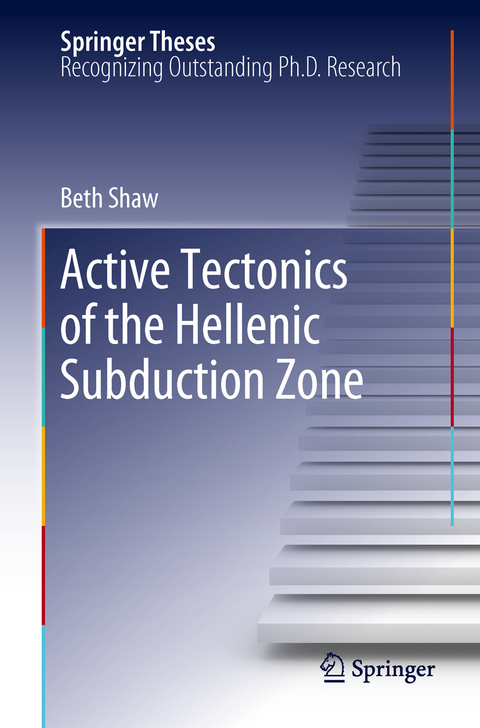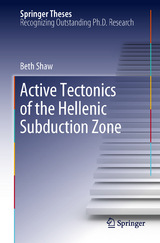Active tectonics of the Hellenic subduction zone
Seiten
2012
|
2012
Springer Berlin (Verlag)
978-3-642-20803-4 (ISBN)
Springer Berlin (Verlag)
978-3-642-20803-4 (ISBN)
This work examines what was responsible for a tsunami that destroyed settlements in the Mediterranean in 365 AD. It details how western Crete was lifted out of the sea by up to 10 meters in a massive earthquake, which occurred on a previously unknown fault.
This thesis is remarkable for the wide range of the techniques and observations used and for its insights, which cross several disciplines. It begins by solving a famous puzzle of the ancient world, which is what was responsible for the tsunami that destroyed settlements in the eastern Mediterranean in 365 AD. By radiocarbon dating of preserved marine organisms, Shaw demonstrates that the whole of western Crete was lifted out of the sea by up to 10 metres in a massive earthquake at that time, which occured on a previously unknown fault. The author shows that the resulting tsunami would have the characteristics described by ancient writers, and uses modern GPS measurements and coastiline geomorphology to show that the strain build-up near Crete requires such a tsunami-earthquake about every 6.000 years - a major insight into Mediterranean tsunami hazard. A detailed seismological study of earthquakes in the Cretan arc over the last 50 years reveals other important features of its behaviour that were previously unknown. Finally, she provides fundamental insights into the limitations of radiocarbon dating marine organisms, relating to how they secrete carbon into their skeletons. The thesis resulted in three major papers in top journals. This thesis is remarkable for the wide range of the techniques and observations used and for its insights, which cross several disciplines. It begins by solving a famous puzzle of the ancient world, which is what was responsible for the tsunami that destroyed settlements in the eastern Mediterranean in 365 AD. By radiocarbon dating of preserved marine organisms, Shaw demonstrates that the whole of western Crete was lifted out of the sea by up to 10 meters in a massive earthquake at that time, which occured on a previously unknown fault. The author shows that the resulting tsunami would have the characteristics described by ancient writers, and uses modern GPS measurements and coastline geomorphology to show that the strain build-up near Crete requires such a tsunami-earthquake about every 6.000 years - a major insight into Mediterranean tsunami hazard. A detailed seismological study of earthquakes in the Cretan arc over the last 50 years reveals other important features of its behaviour that were previously unknown. Finally, she provides fundamental insights into the limitations of radiocarbon dating marine organisms, relating to how they secrete carbon into their skeletons. The thesis resulted in three major papers in top journals.
This thesis is remarkable for the wide range of the techniques and observations used and for its insights, which cross several disciplines. It begins by solving a famous puzzle of the ancient world, which is what was responsible for the tsunami that destroyed settlements in the eastern Mediterranean in 365 AD. By radiocarbon dating of preserved marine organisms, Shaw demonstrates that the whole of western Crete was lifted out of the sea by up to 10 metres in a massive earthquake at that time, which occured on a previously unknown fault. The author shows that the resulting tsunami would have the characteristics described by ancient writers, and uses modern GPS measurements and coastiline geomorphology to show that the strain build-up near Crete requires such a tsunami-earthquake about every 6.000 years - a major insight into Mediterranean tsunami hazard. A detailed seismological study of earthquakes in the Cretan arc over the last 50 years reveals other important features of its behaviour that were previously unknown. Finally, she provides fundamental insights into the limitations of radiocarbon dating marine organisms, relating to how they secrete carbon into their skeletons. The thesis resulted in three major papers in top journals. This thesis is remarkable for the wide range of the techniques and observations used and for its insights, which cross several disciplines. It begins by solving a famous puzzle of the ancient world, which is what was responsible for the tsunami that destroyed settlements in the eastern Mediterranean in 365 AD. By radiocarbon dating of preserved marine organisms, Shaw demonstrates that the whole of western Crete was lifted out of the sea by up to 10 meters in a massive earthquake at that time, which occured on a previously unknown fault. The author shows that the resulting tsunami would have the characteristics described by ancient writers, and uses modern GPS measurements and coastline geomorphology to show that the strain build-up near Crete requires such a tsunami-earthquake about every 6.000 years - a major insight into Mediterranean tsunami hazard. A detailed seismological study of earthquakes in the Cretan arc over the last 50 years reveals other important features of its behaviour that were previously unknown. Finally, she provides fundamental insights into the limitations of radiocarbon dating marine organisms, relating to how they secrete carbon into their skeletons. The thesis resulted in three major papers in top journals.
Introduction.- The AD 365 earthquake: large tsunamigenic earthquakes in the Hellenic Trench.- Earthquakes in the Eastern Mediterranean.- Radiometric dating of uplifted marine fauna in Crete and Central Greece.- Geomorphology.- Conclusions.- Appendices.- References.
| Erscheint lt. Verlag | 13.1.2012 |
|---|---|
| Reihe/Serie | Springer Theses |
| Zusatzinfo | XIII, 169 p. |
| Verlagsort | Berlin |
| Sprache | englisch |
| Maße | 155 x 235 mm |
| Gewicht | 413 g |
| Themenwelt | Naturwissenschaften ► Geowissenschaften ► Geologie |
| Schlagworte | Geologie • Geophysik • Structural Geology |
| ISBN-10 | 3-642-20803-7 / 3642208037 |
| ISBN-13 | 978-3-642-20803-4 / 9783642208034 |
| Zustand | Neuware |
| Haben Sie eine Frage zum Produkt? |
Mehr entdecken
aus dem Bereich
aus dem Bereich




